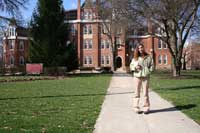Find a College
Resources for Finding New Hampshire Colleges
Where to Start Looking for New Hampshire Colleges
 The New Hampshire Higher Education Assistance Foundation (NHHEAF) is the place to start looking for New Hampshire colleges. NHHEAF sponsors the Center for College Planning in Concord where students can use the library to search for information on colleges. The center provides students with free help in filling out the FAFSA and navigating the college application process. NHHEAF also sponsors an annual free college convention, Destination College, for high school juniors and parents and includes a college fair and college planning workshops.
The New Hampshire Higher Education Assistance Foundation (NHHEAF) is the place to start looking for New Hampshire colleges. NHHEAF sponsors the Center for College Planning in Concord where students can use the library to search for information on colleges. The center provides students with free help in filling out the FAFSA and navigating the college application process. NHHEAF also sponsors an annual free college convention, Destination College, for high school juniors and parents and includes a college fair and college planning workshops.
How to Find Merit Scholarships: Follow the Money, Part 3
 In Part Two of How to Find Merit Scholarships, I said that you need to look at the numbers on institutional aid and non-federal loans to get an idea of which schools are more likely to give out merit money. Now we’ll look at some examples to see how it works.
In Part Two of How to Find Merit Scholarships, I said that you need to look at the numbers on institutional aid and non-federal loans to get an idea of which schools are more likely to give out merit money. Now we’ll look at some examples to see how it works.
How to Find Merit Scholarships: Follow the Money, Part 2
(Part 1 showed how to identify colleges that are likely sources of merit money.)
 Now that you know who has the money, you need to target those schools more likely to be giving it away. I do this by looking at information on institutional grants. This is money the school is giving the student and is usually the largest single source of financial aid for an individual student at private schools. Since IPEDS doesn’t require the school to distinguish between need and merit based grants, I also look at the percentage of freshman who receive the institutional grants.
Now that you know who has the money, you need to target those schools more likely to be giving it away. I do this by looking at information on institutional grants. This is money the school is giving the student and is usually the largest single source of financial aid for an individual student at private schools. Since IPEDS doesn’t require the school to distinguish between need and merit based grants, I also look at the percentage of freshman who receive the institutional grants.
How to Find Merit Scholarships: Follow the Money
 There are 1,586 public and not-for-profit colleges with 500 or more full-time undergraduates. Which of them are likely to give you merit scholarships? Unfortunately, there’s really no one right way to search for such colleges. After all, the college that provides a generous amount of merit scholarship to one student will deny it to another.
There are 1,586 public and not-for-profit colleges with 500 or more full-time undergraduates. Which of them are likely to give you merit scholarships? Unfortunately, there’s really no one right way to search for such colleges. After all, the college that provides a generous amount of merit scholarship to one student will deny it to another.
415 Colleges with at least 50% Acceptance Rates and 50% Graduation Rates
 I’ve finally finished updating my list of 50-50 colleges. There’s nothing sophisticated about the 50-50 list, it’s simply a list of all colleges and universities that accept at least 50% of students and have at least a 50% graduation rate. That means that these are schools most students could get into and have a good chance of graduating as well.
I’ve finally finished updating my list of 50-50 colleges. There’s nothing sophisticated about the 50-50 list, it’s simply a list of all colleges and universities that accept at least 50% of students and have at least a 50% graduation rate. That means that these are schools most students could get into and have a good chance of graduating as well.
6 Options for Public Liberal Arts Colleges
 Liberal Arts Colleges are known for their focus on undergraduate teaching. They’re generally small with few or no graduate students and rank high in student engagement in research, internships, and culminating senior experiences. They can be very good for preparing students for graduate school. And they’re overwhelmingly private institutions.
Liberal Arts Colleges are known for their focus on undergraduate teaching. They’re generally small with few or no graduate students and rank high in student engagement in research, internships, and culminating senior experiences. They can be very good for preparing students for graduate school. And they’re overwhelmingly private institutions.
Moneyball College Admissions Rules: Ignore Peer Pressure
 I’m always amazed at the absolute certainty people have of the superiority of one college over another. Spend a little time on College Confidential and you’ll see high school students looking for advice on which school to attend bombarded with definitive statements of the overwhelming excellence of one school compared to another. Sometimes they’ll point to rankings but more often than not, the opinions will be based on their experience with just one of the schools in question.
I’m always amazed at the absolute certainty people have of the superiority of one college over another. Spend a little time on College Confidential and you’ll see high school students looking for advice on which school to attend bombarded with definitive statements of the overwhelming excellence of one school compared to another. Sometimes they’ll point to rankings but more often than not, the opinions will be based on their experience with just one of the schools in question.

